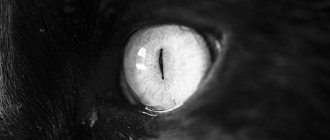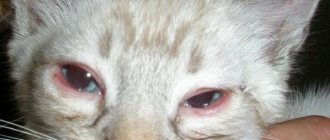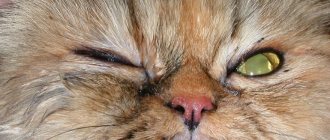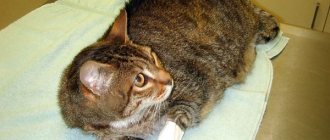Eyes are the mirror of the soul! We often say this phrase when talking about people. But, believe me, our four-legged pets also have very “talking eyes.” And since they cannot tell us about their feelings and desires in words, it is necessary to peer into these eyes more often. Remember, in them you will see love, devotion, and complete trust. They will tell you about the health status of your pet and will be able to warn you about possible problems. So, in this article we will find out why our pet’s eyes may become watery, what needs to be done in this case, and how to avoid possible diseases.
Tearfulness is a fairly common occurrence among our four-legged friends. This can be an indicator of a fairly serious disease, and sometimes it can only be the body’s reaction to debris or dust getting into the eyes. Another reason for severe tearing is dry air in the room. If it is not possible to increase the humidity, then it is necessary to instill in your pet’s eyes special moisturizers - “Artificial tears”, “Hypromellose”, “Dacrolux”. They have a lubricating and softening effect, protecting the eyes instead of tear fluid.
There are dog breeds that are prone to eye diseases, and for cats, the eyes are generally one of the most vulnerable organs.
Tears play a very important role - they cleanse and protect the eyes. They have an antibacterial effect and wash away all excess. Tear fluid is a natural protective reaction to various irritants, and therefore dogs and cats, like people, often have watery eyes, because this is the only way to moisturize their surface and get rid of any negative external factors. However, to begin with, it is worth noting that there are two main types of discharge from the eyes of an animal - mucous and purulent. To determine the disease, it is important to distinguish between them. Purulent discharge has a thicker consistency and a fairly rich greenish or yellowish tint. Oxidized tears are slightly brown or slightly reddish in color.
The animal's eyes are watery: reasons
Tearing can occur either from natural causes or as a result of illness.
In the first case, tears from the eyes may appear:
- After the furry animal woke up. This is a normal reaction of the body. The cat removes traces of tears itself by washing its face. For kittens, you can wash their eyesight with a swab moistened with boiled water.
- If the cat belongs to a certain breed. The Persian, the British, the Sphinx have tears and a peculiarity of the body. Persians are too fluffy, and doctors often diagnose the Sphynx breed with a disease called “entropion.” In this case, the animal can only be cured by resorting to surgery.
- If hair fibers get on the cornea. This symptom often occurs in long-haired small carnivores. The only thing that will help your cat is regular eye care.
In the second case, the cat may cry due to:
- Mechanical damage, injuries. A pet can damage the eyelid, eye, or cornea in a confrontation with another representative of its breed, during play or a walk. A sharp blade of grass or a twig that scratches the organ of vision can cause serious inflammation.
- Foreign objects. A small speck, a piece of tree bark, or a piece of plastic is enough to cause an inflammatory process to develop in a cat’s eye. Treatment in this case includes procedures for treating with solutions of antibacterial drugs.
- Burn. Curious animals often stick their noses into everything they find at home. Aggressive household chemicals, solvents, and wood varnish can become an object of curiosity, which will lead to a chemical burn. A pet can get a thermal burn if it becomes interested in cooking in the kitchen.
- Allergic reaction. Allergies are the scourge of the modern world; not only people, but also animals are susceptible to manifestations of allergies to various irritants.
- Incorrect eyelash growth. Sometimes a cat has a pathology - the eyelashes grow incorrectly, causing the pet a lot of suffering: the eyelid is inflamed, tears constantly ooze. In this case, the help of a veterinarian is required.
- Helminth infections. One of the signs of the disease is increased production of tears.
- Conjunctivitis. The infection is caused by chlamydia; only a veterinarian can cure the little predator.
- Colds. A cat often cries if it has a cold.
Be sure to read:
The cat eats poorly and loses weight: causes, safe and dangerous symptoms, first aid, treatment
How to eliminate tearing?
In order to help your pet, it is not enough just to consult a veterinarian and purchase the appropriate product. You should definitely know how to use it correctly in order to help and not harm your pet. Here is a list of simple but very effective rules:
- Wash your hands to avoid spreading dirt and infection into your pet's eyes.
- Take saline or chlorhexidine. There is no need to use tea leaves or unstrained herbal decoctions for this procedure, since a fine fraction can cause even more problems for the animal, which is important to avoid in case of conjunctivitis and other diseases. Gently use a cotton swab dipped in saline solution or warm water to clean the hair around the eyes and eyelid area. The saline solution will simply remove dirt from the eyes. But if the eyes are not only watery, but irritated and inflamed, then it is better to use chlorhexidine as a preventive measure for inflammation. This product is completely safe for your animal and will not cause any pain.
- Tilt your pet's head back and try to fix the position with one hand. Here you will need firmness and confidence in your movements, as well as a strong grip, otherwise the dog may suddenly break free and get hurt during burying. It is better, of course, to carry out this eye cleaning together, because... Not all pets like hygiene procedures. Be sure to praise your pet after the procedure and give him something tasty!
- How to wash a dog’s eyes at home if they are very watery or if a foreign object has gotten into them? Again, we suggest using chlorhexidine or vetericin. We have already talked about the benefits of chlorhexidine earlier. In this case, it is better to even use vetericin, because it relieves irritation faster and destroys more germs. Place the product in the eyes and let the dog blink. Be calm, your pet will not be hurt. Vetericin, like chlorhexidine, does not pinch or burn.
- As for humans, the ointment is placed in the conjunctival sac. To do this, the eyelid is pulled back a little, and the product is squeezed into the resulting pocket.
- My dog's eye is watering, what should I do? Be sure to use the product prescribed by your veterinarian in both eyes. This must be done not only for treatment, but also for eye prevention.
A cat's eye is watering: what to do?
Excessive production of tears from one eye requires immediate action on the part of the owner:
- Assessment of general condition. It is necessary to conduct a visual inspection, measure body temperature, and examine the cat for injuries.
- Treatment of the affected eye with furatsilin (solution), decoctions of medicinal herbs.
- A trip to the veterinary clinic.
During treatment, a number of rules should be followed:
- Rinse both healthy and affected organs of vision.
- Remove the allergen from the home if an allergic reaction is diagnosed.
- When treating an infection, lubricate the eyes with ointments 2 times a day.
- If surgery is required, do not remove the special collar from the cat until complete healing.
How is eye injury treated?
Treatment is selected based on the type and extent of eye damage. In mild cases, we manage with drug therapy, which includes antibacterial drugs, non-steroidal anti-inflammatory drugs, painkillers and hormonal eye drops. For moderate and severe burns, the patient is hospitalized; for serious wounds, surgery is performed. Treatment after an eye injury involves using drops recommended by your doctor.
Consequences of eye injury
The consequences of damage depend on its extent and the quality of assistance provided. Doctors treat wounds and carry out all necessary manipulations, so if you quickly go to the emergency room, there will be fewer complications. Undesirable consequences are associated with infection entering the blood or even greater injury as a result of rash actions.
If a person does not receive timely medical care, scars remain, the soft tissues around the eye are deformed, and visual acuity decreases until it is completely lost.
If the infection enters the blood, sepsis develops - inflammation that is dangerous to the entire body. Accumulating pus affects the internal structures of the eye, sometimes reaching the brain, causing inflammatory processes in the body.
What can you do at home?
Get rid of drafts at home and make sure your cat doesn't get too cold. Check her diet. If necessary, consult a veterinarian and add a vitamin complex to its usual food so that the animal receives all the necessary nutrients. This will strengthen your immune system and improve your overall condition. Do not forget about regular prevention of parasites.
Do not wash your cat's eyes with a solution of potassium permanganate. Yes, it is known for its disinfecting properties, but at the same time it dries out the mucous membrane and can even burn it. In addition, if manganese crystals are poorly soluble in water and get into the eye, they can cause irreparable damage to vision.
Should I worry?
Tears do not appear by chance - they do not allow the cornea to dry out.
The released liquid cleanses the eyes of dust that has entered them and washes away germs. Therefore, if a cat begins to cry, this is not always a sign of a serious problem .
A small amount of fluid accumulates in the corners of the eyes when the animal sleeps.
Dried crusts do not cause discomfort to the cat and are not a cause for concern. If the pet is too lazy to remove them himself, the owner can help him - rinse his eyes with warm boiled water.
Alarming symptoms
You should worry when tearfulness has become a constant symptom. This indicates health problems.
Additional symptoms appear:
swollen eyes;- redness of the conjunctiva;
- corneal clouding;
- release of viscous liquid;
- itching causing the cat to rub its eyes.
The protracted process is accompanied by fever and photophobia. Skin problems develop in the eye area (dermatitis, eczema), causing hair loss here.
The mood of a sick cat also changes - it becomes depressed, refuses to eat and does not show playfulness.
2.Signs of an eye infection
After an eye burn, it is important to watch for possible signs of an eye infection.
. These include:
- Eye pain;
- Sensation of a foreign body in the eyes;
- Yellowish, greenish, or bloody discharge from the eyes;
- Increased sensitivity to light (photophobia);
- Redness of the eyes or eyelids;
- High temperature without other reasons for this;
- Blurred and impaired vision.
If there are any signs of eye infection after a burn, it is important to consult a doctor. In addition, a visit to the doctor is necessary after a chemical burn to the eyes in order to notice eye damage in time and avoid deterioration or loss of vision.
Visit our Traumatology and Orthopedics page
How to treat your pet at home
Having discovered that the cat's eye is watering, they find out the cause of the problem.
But you should not self-medicate. The only thing the owner can do before going to the vet is to rinse the pet's eyes.
First aid for watery eyes
The washing procedure is rational in cases where a foreign body, an irritating substance has gotten under the cat’s eyelid, or the animal has been injured.
It is best to use saline solution (0.2% Furacilin) in this situation, but it may not always be at hand.
Therefore, prepare boiled water and proceed to the following actions:
the liquid is cooled;- moisten a cotton pad in water and apply it to the pet’s eye;
- wipe, moving from the inner corner to the outer.
If there is a lot of discharge, pus or blood is present, the discs are changed several times during the treatment process. In this case, new material is taken for the next eye.
To make the procedure more convenient, it is recommended to involve an assistant who will hold the resisting cat.
Professional diagnostics
Only a specialist can determine how serious the pathology is. At the veterinary clinic, a comprehensive examination of the animal is performed, all necessary tests are taken, as well as eye washes.
The results obtained are correlated with the owner’s story about how the disease developed, what symptoms accompanied tearfulness, and whether the pet’s behavior changed. This helps the doctor fully assess the situation and choose the right treatment.
Medications
All medications are prescribed based on the cause of lacrimation:
for conjunctivitis, Kanamycin, Levomycetin or Sofradex are recommended: the prescribed drug is instilled into the affected eye up to 5 times a day;- if the doctor prescribes antibiotics in the form of an ointment (Tetracycline is most often prescribed), then it is applied 3 times a day;
- if the eyelid and dermis near the eye are swollen, and the cat experiences severe pain, then it is prescribed hydrocortisone or novocaine.
Ophthalmological diseases require specific treatment, which is selected individually in each specific case.
Before removing the foreign body, the cat is given an anesthetic injection. Then, taking a cotton swab, roll the eyelid outward and try to remove the foreign object from the eye with tweezers.
Folk recipes
You can wash the eyes of sick cats using the same folk remedies as used in treating people. For excessive tearing, herbal decoctions (St. John's wort, calendula, chamomile, sage) help well. You can also make lotions with single-use black tea bags.











